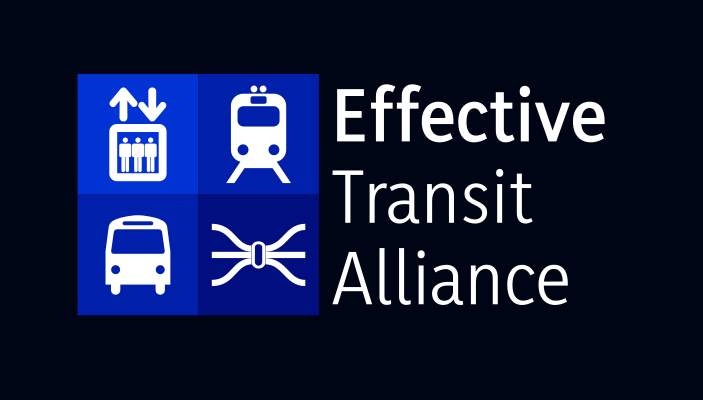Six-Minute Service: Response to MTA
The MTA is planning a significant expansion of off-peak service over the coming year. ETA strongly supports Riders’ Alliance in its campaign for six-minute service.The finalized boosts move the system in the right direction. Still, the MTA should do more.
The Increases in Service…
The first wave, expected to begin in July, will boost weekend service frequency on the G, J and M trains to every 8 minutes, up from the current 10 minutes.
Beginning in August, the MTA plans to add more trains to the midday Monday-Friday service on the C, N and R — pushing frequencies on those lines to every 8 minutes from every 10 minutes as well.
This December, plans call for increasing weekday evening service on the C, N and R trains to every 8 minutes, up from every 10-12 minutes. The G would see trains arrive every 8 minutes during its midday Monday-Friday service. Officials also expect to expand the weekend six-minute schedules on the 1 and 6 trains to cover more hours on Saturdays and Sundays.
The third tranche is expected by summer 2024, when the MTA plans to increase Monday-Friday midday and evening service on the B, D, J and M lines to every 8 minutes. The 3 and 5 lines would see running every 10 minutes instead of every 12 on weekends.The 1 and 6 lines will each get a train every 6 minutes during midday Saturdays and Sundays.
…are a good start, but are not Enough
The current plan would only establish six-minute headways on two services: the 1 and 6 trains, both of which run without sharing tracks with any other line. This is less frequent than both lines were 10 years ago, when they ran every five minutes. We call for six-minute frequencies on services that share tracks with other lines, so that neighborhoods like Inwood, Crown Heights, Queensbridge, and Cobble Hill can get six-minute service. On the 1 and 6, even more frequency is needed, since on those local lines people are usually making very short trips, switching to express trains on longer trips. Instead, the plan leaves Queensbridge, Cobble Hill, and similar such neighborhoods with 10-minute headways.
Moreover, while we applaud that the state is finding money to increase weekend service, we are dismayed that so little work is done to improve midday service. The marginal operating costs of adding subway service between the morning and afternoon peaks are low. Systems that maintain consistently frequent service during the whole day benefit from simplified crew scheduling with fewer split shifts. Unless rush hour frequency is very high, the cost of keeping the same frequency from 7 am to 7 pm on weekends is low and the benefits to passengers are high; Berlin runs flat five-minute service on the U-Bahn, and BART runs 16 trains per hour across the Bay midday split across four branches, almost as many as the 22 it ran at rush hour before corona.
Maintenance and Frequency
As in the past, off-peak service increases are conflicting with the MTA’s poor maintenance productivity. The MTA has likely tailored service increases in large part around maintenance changes it perceives as feasible. The planned service boost relies on a slight increase to the speed at which trains are permitted to pass work zones to 15 mph. Current policy in place since 2007 allows 10 mi/h, which severely constricts throughput; under the existing rule, even the planned service increases are next to impossible. Of note, MTA maintenance workers also get hurt more often than average.
The MTA should work with its maintenance forces and assimilate best practices from other systems on further productivity and safety improvements. Several US transit systems complete significantly more maintenance per person-hour than does the NYC Subway, generally with few to no opportunities to reroute trains. The trains were, if anything, slightly more reliable in the 2000s than in the second half of the 2010s.
Tweaks and Paradigm Shifts
Six-Minute Service is about raising frequency, but also much more. It is a paradigm shift, all of whose components improve public transit service in New York in interaction with one another:
| Traditional scheduling | Six-Minute Service |
|---|---|
| Peak-focused scheduling | Nearly flat all-day scheduling |
| Frequency is just a way to provide capacity | High frequency brings in ridership by itself |
| Each service has a separate frequency | All services sharing tracks run the same frequency |
| Frequent tweaks to individual frequency | Relatively static, optimized schedule |
| Off-peak trains run around maintenance | Maintenance is done around off-peak trains |
The transition to Six-Minute Service is about recognizing the importance of all its aspects. The NYCT plan takes some steps in the right direction on the first two goals, but falls short even there with its partial increases keeping headways at eight or even 10 minutes; it has no recognition of the importance of the last two goals, even though consistent all-day frequencies on all lines, even if they are lower, would make the trains noticeably more reliable and even faster, because they wouldn’t have to wait at merge points. It is imperative that the aforementioned service changes that will be rolled out over the next year be a beginning, not an end. Accordingly, we urge the MTA to build on the progress that it has made and use Six-Minute Service as a driving force for changes that will build ridership and strengthen the MTA as an organization.
